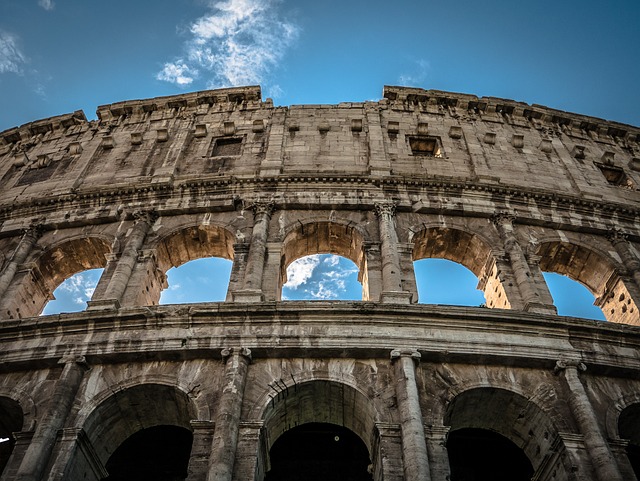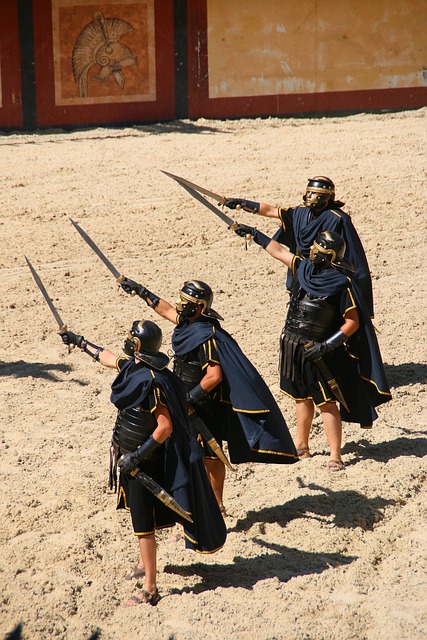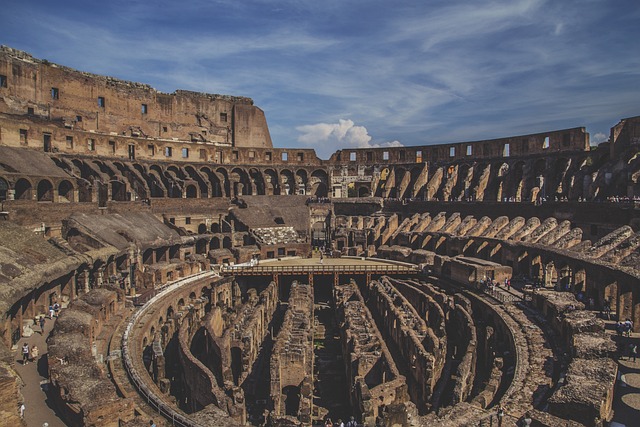The Roman Colosseum is a world-renowned symbol of ancient Rome, attracting millions of tourists each year. However, behind its grand facade lies a dark and gruesome past that often goes unacknowledged.
In this article, we will delve into the lesser-known history of the Colosseum, shedding light on the disturbing events that took place within its walls.

Understanding the history of this iconic structure is crucial in fully comprehending its significance and impact on ancient Roman society.
So, let’s take a look at the grim chronicles of the Roman Colosseum and uncover its dark past that has been buried for centuries.
Table of Contents
The Construction of the Roman Colosseum
The Roman Colosseum is a magnificent structure that stands as a symbol of ancient Rome’s power and grandeur. This iconic amphitheater, also known as the Flavian Amphitheater, was constructed between 70-80 AD during the reign of Emperor Vespasian and his son Titus. It was primarily built as a venue for public entertainment, but its construction also served political and societal purposes.
The construction of the Colosseum was no small feat. It took over 8 years to build and required thousands of workers, including skilled engineers and architects. The Colosseum’s massive size, with a capacity of over 50,000 spectators, made it one of the largest amphitheaters in the ancient world. This was achieved through the use of advanced engineering techniques, such as the use of concrete and arches, which allowed for the creation of multiple levels and seating tiers.
The construction of the Colosseum was also a reflection of Rome’s advanced engineering skills. The use of concrete, a mixture of volcanic ash, lime, and water, was a revolutionary building material at the time. It allowed for the creation of large and durable structures, such as the Colosseum, which still stands today despite centuries of wear and tear.
The purpose of the Colosseum’s construction went beyond providing a venue for public entertainment. It was also a way for the ruling elite to showcase their power and wealth. The construction of such a massive structure required significant resources and manpower, which only the wealthy and powerful could afford. This further solidified their status and authority in society.
The Colosseum also had a significant impact on ancient Roman society. It served as a way to distract and appease the masses, often with free admission and lavish spectacles. It also provided employment opportunities for thousands of people, from gladiators and performers to merchants and craftsmen. In a society where unemployment was high, the Colosseum was a means of maintaining social order.
Additionally, the construction of the Colosseum and its grandeur reflected the values of ancient Rome. The emphasis on physical strength, power, and violence was glorified in the events held at the Colosseum, such as gladiator fights and animal hunts. These events were seen as a way to honor the gods and reinforce the idea of Rome’s dominance and superiority over other civilizations.
In conclusion, the construction of the Roman Colosseum was a monumental undertaking that served various purposes. It showcased the advanced engineering skills of ancient Rome, provided entertainment and employment opportunities, and reinforced the power and values of the ruling elite. However, behind its grand facade and impressive engineering, the Colosseum also had a dark side that is often overlooked. This will be explored further in the next section of this article.
The Gladiators: Heroes or Victims?
The word “gladiator” often evokes images of brave and skilled warriors fighting for glory and honor in the Roman Colosseum. However, the reality of being a gladiator was far from glamorous. These men were not only skilled fighters, but also victims of a brutal and exploitative system.
Gladiators were typically prisoners of war, slaves, or criminals who were forced to fight for entertainment in the Colosseum. They were trained in specialized schools called ludi, where they learned various fighting techniques and weapons. However, this training was not for the purpose of self-defense, but rather for entertainment and profit.

Life as a gladiator was harsh and dangerous. They were constantly subjected to rigorous training and had to endure brutal living conditions. Many gladiators were malnourished and suffered injuries from training and fighting. Moreover, they were treated as property and had no control over their own lives.
One might argue that gladiators were viewed as heroes in ancient Rome because of their bravery and skill in the arena. However, this view is not entirely accurate. Gladiators were seen as nothing more than disposable commodities, and their lives were not valued by society. They were considered to be at the lowest rung of the social ladder, even below slaves.
Furthermore, gladiators were not always willing participants in their fights. Many were forced into the arena against their will, either through debt or as punishment for a crime. This raises the question of whether they were truly heroes or simply victims of a cruel and oppressive system.
In addition to their physical hardships, gladiators also faced psychological challenges. They were constantly in fear for their lives, knowing that death could be just one wrong move away. This psychological trauma was further compounded by the fact that they were often pitted against each other, forcing them to fight and kill their fellow gladiators.
The gladiatorial games themselves were a reflection of the violent and brutal nature of ancient Roman society. It was a spectacle of blood and death, with the audience clamoring for more gruesome and shocking displays. This thirst for entertainment at the cost of human life speaks volumes about the values of that time.
Despite their hardships and mistreatment, some gladiators did achieve fame and glory in the arena. Their names and achievements were celebrated by the crowds, and some even gained their freedom after successful fights. However, these instances were rare and did not change the overall oppressive system in which they were trapped.
In conclusion, the gladiators of the Roman Colosseum were both heroes and victims. They were skilled fighters who displayed courage and determination in the face of death, but they were also victims of a cruel and exploitative system. Their stories serve as a reminder of the dark side of the Colosseum’s history and the human cost of entertainment.
The Dark Side of Entertainment: Gruesome Events at the Colosseum
As one of the most iconic and visited structures in the world, the Roman Colosseum has captured the imagination of people for centuries. From its grandeur and advanced engineering to its bloody and violent history, the Colosseum has a dark past that is not as widely known as its architectural feats. In this section, we will delve into the grim events that took place within the walls of the Colosseum and the psychological impact they had on both the spectators and the participants.
The purpose of the Colosseum was to provide entertainment to the citizens of ancient Rome. However, this entertainment came at a high cost, both to the animals and the human victims who were forced to participate in these events. Animal fights were a popular form of entertainment in the Colosseum, with exotic animals being brought in from all over the Roman Empire. Lions, bears, elephants, and even crocodiles were pitted against each other or against gladiators, resulting in gruesome and bloody battles.
Executions were another form of entertainment in the Colosseum, with criminals and prisoners of war being publicly executed in front of a cheering crowd. These executions were often carried out in creative and brutal ways, such as being burned alive or torn apart by wild animals. The psychological toll of witnessing these events cannot be underestimated, as it desensitized the spectators to violence and death.
The gladiators, who were trained fighters forced to participate in the events, also suffered immensely. They were often slaves or prisoners of war who had no choice but to fight for their lives in the Colosseum. Their training was brutal, and they were treated as nothing more than commodities by their owners. Despite being idolized as heroes by the public, they were victims of a society that valued entertainment over human life.
In addition to animal fights and executions, the Colosseum also hosted reenactments of famous battles and mythological stories, often with real weapons and combat. These events were highly choreographed and rehearsed, but accidents and deaths were still common. The pressure to perform and the constant threat of death took a toll on the gladiators, who were often heavily drugged to dull their senses and make them more aggressive in the arena.
The psychological impact of these events extended beyond the participants and the spectators. The political and societal implications of the Colosseum’s events were far-reaching. It was a means for the ruling elite to maintain their power and control over the masses. Marginalized groups, such as slaves and Christians, were often forced to participate in these events as a form of punishment and public humiliation.
As the Roman Empire declined, so did the popularity of the Colosseum. In the 5th century, Emperor Honorius officially banned gladiator games, and the Colosseum was eventually abandoned. However, its legacy continues to this day, with the Colosseum being a popular tourist attraction and a symbol of the power and excess of ancient Rome.
In conclusion, while the Colosseum may be a marvel of engineering and a symbol of the grandeur of ancient Rome, it also has a dark and violent history that should not be forgotten. The events that took place within its walls serve as a reminder of the destructive nature of human beings and the danger of valuing entertainment over human life.
The Colosseum as a Symbol of Power and Oppression
The Roman Colosseum, with its grandeur and size, has long been a symbol of power and dominance. It stands as a testament to the might and wealth of the Roman Empire. However, beneath the splendor and glory, lies a dark history of oppression and exploitation.
The events that took place in the Colosseum were not merely for entertainment, but also served as a means for the ruling elite to maintain their power and control over the masses. The gladiatorial fights and other gruesome events were not just for the pleasure of the spectators, but also a display of the Emperor’s authority and superiority.
The gladiators, who were the main attraction of the Colosseum, were not willing participants in these events. They were primarily slaves, prisoners of war, and criminals who were forced to fight for their lives. They were stripped of their freedom and dignity, and their lives were at the mercy of the whims of the audience and their owners.
The training and daily lives of gladiators were brutal and dehumanizing. They were subjected to harsh physical and mental training, and their lives were constantly at risk. They were treated as disposable commodities, with no regard for their well-being. Despite their bravery and skill in the arena, they were still viewed as mere objects and were not given the respect and honor that they deserved.

The Colosseum also served as a platform for the ruling elite to oppress and control marginalized groups, such as slaves and Christians. These groups were often forced to participate in the events, either as performers or victims. Slaves were seen as expendable and were used as fodder for the gladiatorial fights. Christians, on the other hand, were persecuted and executed in front of the cheering crowds, as a means to suppress their beliefs and maintain the dominance of the Roman religion.
The events at the Colosseum also had a significant impact on the psychological well-being of both the spectators and participants. Witnessing acts of violence and death on such a massive scale could desensitize the audience and instill a sense of bloodlust. The gladiators, on the other hand, were constantly living in fear and trauma, knowing that their lives could end at any moment.
Despite the decline of the Colosseum and its eventual abandonment, its legacy of power and oppression still resonates in modern times. The cultural and historical significance of the Colosseum has made it a popular tourist destination, with millions of visitors each year. However, there is also controversy surrounding the preservation and restoration of the Colosseum. Some argue that it should be left in its ruined state, as a reminder of the dark events that took place there, while others believe that it should be restored to its former glory.
In conclusion, the Roman Colosseum may be a magnificent architectural marvel, but it also holds a grim history of power and oppression. It serves as a reminder of the darker side of human nature and the lengths that people will go to maintain their power and control over others. We must remember and learn from this past, so that we may strive for a more just and equal society.
The Decline and Legacy of the Roman Colosseum
The grandeur and brutality of the Roman Colosseum made it an iconic symbol of ancient Rome. However, as time passed, the Colosseum’s popularity gradually declined, and it eventually fell into ruin. In this final section, we will explore the reasons for its decline and examine its enduring legacy on modern society. The decline of the Colosseum can be attributed to a combination of factors.
One of the main reasons was the decline of the Roman Empire itself. As the empire’s power waned, so did the lavish expenditures on events at the Colosseum. Additionally, the rise of Christianity in the Roman Empire, with its opposition to gladiatorial games, also played a role in the decline of the Colosseum. Over time, the Colosseum was used for other purposes, such as housing, workshops, and even a church. This led to further damage and deterioration of the structure.
In the Middle Ages, earthquakes and other natural disasters also took a toll on the Colosseum. By the 16th century, it had become a mere shell of its former glory. Despite its downfall, the Colosseum’s legacy lives on. Its enduring architectural design and engineering techniques have influenced numerous structures in modern times. The Colosseum also continues to be a major tourist attraction, with millions of visitors each year. Its impressive size and the gruesome history it holds make it a popular destination for tourists seeking to learn more about ancient Rome. However, the Colosseum’s legacy is not without controversy.
The preservation and restoration efforts have sparked debates among historians and archaeologists. Some argue that the modern additions and reconstructions have taken away from the Colosseum’s authenticity and historical value. Others argue that these efforts are necessary to protect the structure from further deterioration. Moreover, the Colosseum also serves as a reminder of the darker aspects of human nature.
The events that took place within its walls were a reflection of the society’s thirst for violence and entertainment. It also highlights the power dynamics and oppression that existed in ancient Rome, where the ruling elite held sway over the lives of their subjects.
In conclusion, the Roman Colosseum’s decline and legacy are a testament to its enduring significance in history. Despite its dark past and eventual downfall, the Colosseum remains a symbol of power, engineering marvel, and the impact of societal values on the world’s most iconic structures.
Its preservation and continued study will provide valuable insights into ancient Rome and its lasting impact on modern society.
